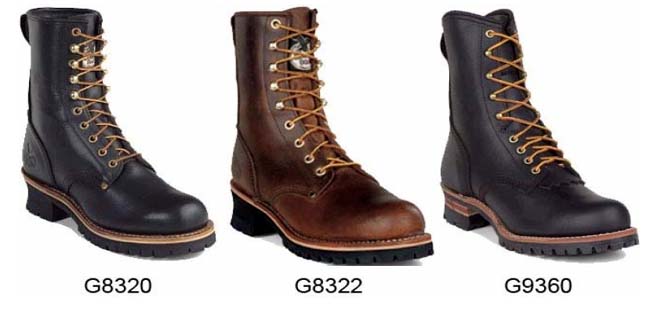|
 |
U. S. Department of Labor
Occupational Safety and Health Administration
Directorate of Science, Technology and Medicine
Office of Science and Technology Assessment
|
Potential Hazards of Mislabeled Steel Toe Logger Boots
|
|
Safety and Health Information Bulletins |
|
|
SHIB 09-30-2004 |
|
This Safety and Health Information Bulletin is not a standard or regulation, and it creates no new legal obligations. The Bulletin is
advisory in nature, informational in content, and is intended to assist employers in providing a safe and healthful workplace. The
Occupational Safety and Health Act requires employers to comply with hazard-specific safety and health standards. In addition, pursuant to
Section 5(a)(1), the General Duty Clause of the Act, employers must provide their employees with a workplace free from recognized hazards
likely to cause death or serious physical harm. Employers can be cited for violating the General Duty Clause if there is a recognized hazard
and they do not take reasonable steps to prevent or abate the hazard. However, failure to implement any recommendations in this Safety and
Health Information Bulletin is not, in itself, a violation of the General Duty Clause. Citations can only be based on standards,
regulations, and the General Duty Clause. |
Purpose
The purpose of this Safety and Health Information Bulletin is:
- To alert employers and employees of the potential electrical hazards of Georgia Boot’s mislabeled steel toe logger boots;
- To provide Georgia Boot customers with the manufacturer’s recall instructions for the subject boots; and
- To remind users of OSHA’s requirements for electrical protective equipment as covered by 29 CFR 1910.137.
Background
Georgia Boot, a manufacturer of steel toe safety boots, has discovered that three models of its logger boots may have been mislabeled "EH,"
thus incorrectly indicating that they are resistant to electrical current. This may result in an increased risk of electric shock or
electrocution to employees who use these boots for supplemental protection against electrical current, since these boots are not designed to
provide insulation or protection against electrical current.
Other Information
Georgia Boot, of Franklin, Tennessee, in cooperation with the U.S. Consumer Product Safety Commission (CPSC), has voluntarily recalled
approximately 10,000 pairs of steel toe logger boots. See CPSC Press Release # 04-177,
http://www.cpsc.gov/cpscpub/prerel/prhtml04/04177.html
issued on July 14, 2004. Since these boots are industrial steel toe safety boots, it is important to make employers and employees aware of
this potentially hazardous condition when these boots are used for supplemental protection against electrical hazards.
The recalled steel toe logger boots are brown and black and have laces that tie up to the calf. The stock numbers for these boots are G8320,
G8322, and G9360. The stock numbers can be found on a label under the tongue of the boot. The same label has stitching of the "Georgia Boot"
name.
These boots were sold in retail shoe stores and independent retail stores from October 2002 through April 2004.
Georgia Boot has not received any reports of incidents. The CPSC/Georgia Boot recall is conducted to prevent the possibility of injuries.
Technical Information
Electrical hazard footwear is constructed to provide insulation of the wearer’s feet from a grounded surface. This can provide a small degree
of protection from electric shock for the wearer. This protection is limited to voltage of 600 volts or less under dry conditions and is
intended to be a secondary form of electrical insulation.1 Using electrical hazard footwear as a primary form of electrical
protection could expose employees to electric shock hazards if they believe that the primary form of electrical protection (for example,
rubber insulating gloves or blankets) is no longer necessary. The electrical hazard footwear only insulates an employee’s feet from grounded
surfaces. The employee can still be grounded through other parts of his or her body. In addition, the insulation provided by electrical hazard
footwear is good only under dry conditions, providing little protection in a wet or damp environment, and only for ratings of 600 volts or
less. Employees exposed to electrical hazards need to use suitable electrical protective equipment as covered by OSHA standards including 29
CFR 1910.137;29 CFR 1910.269(l); and 29 CFR 1926.950(c).
Conclusion
OSHA reminds employers that employees exposed to electrical hazards must use suitable electrical protective equipment as required by OSHA
standards and recommends that employers follow the recall instructions for these mislabeled steel toe logger boots listed on the
manufacturer’s website.
http://www.georgiaboot.com/content/index.cfm?method=productnotice050406.
 |
|
Footnotes
- Primary insulation normally insulates an employee directly from an energized part. Rubber insulating gloves and rubber insulation
blankets are examples of primary electrical protection. Secondary insulation normally insulates an employee’s feet from a grounded surface.
Electrical hazard footwear and rubber insulating matting are examples of secondary electrical protection.
|

